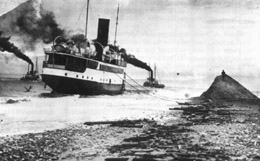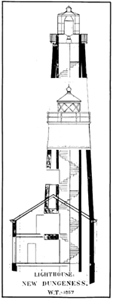
 The New Dungeness Spit derived its name from Captain
George Vancouver who named it after Dungeness Point on the rugged
coast of England where a lighthouse had stood since 1746.
The New Dungeness Spit derived its name from Captain
George Vancouver who named it after Dungeness Point on the rugged
coast of England where a lighthouse had stood since 1746.
In 1850, a Congressional Act provided for a lighthouse
at New Dungeness. Several years later funding was provided for
lighthouses: Willapa Bay, Cape Flattery, Smith Island and New
Dungeness. Construction was completed on all four in 1857–58.
New Dungeness was the first to light, on December 14, 1857, making
it the first to be lit in the Strait of Juan de Fuca-Puget Sound
areas, and the second to be lit north of Cape Disappointment.
New Dungeness and Cape Flattery are the only two lighthouses surviving,
with New Dungeness the only one open to visitors.
 New Dungeness Lighthouse was originally one-sixth
of a mile from the tip of the spit. It now sits approximately
one-half mile from the tip. The spit continues to grow.
New Dungeness Lighthouse was originally one-sixth
of a mile from the tip of the spit. It now sits approximately
one-half mile from the tip. The spit continues to grow.
In 1868 eighteen Tsimshian Indians, (men, women &
children) were massacred by the Clallam Indians as they camped
on the spit. One pregnant woman escaped and was sheltered by keeper
Henry Blake. The son of this woman returned years later to visit
the lighthouse.
 Even with the light and fog bells and horns, the
spit has quite a history of shipwrecks, including the bark Christopher
Mitchell, the Washington Libby, the R.K. Ham
and the steamer Sioux.
Even with the light and fog bells and horns, the
spit has quite a history of shipwrecks, including the bark Christopher
Mitchell, the Washington Libby, the R.K. Ham
and the steamer Sioux.
In 1895 funds were requested to build a new dwelling.
It was built for $4500.00, a Cape Cod style two story house having
fine woodwork, three bedrooms and ample space for family living.
The date of completion, 1904, is carved into the front of the porch
roof.
 In 1915 the spit attracted national attention when
President Woodrow Wilson decreed it to be a Department of Agriculture
wild bird reservation with access by the public permitted. Today,
it is the Dungeness National Wildlife refuge, managed by the US
Fish & Wildlife Service.
In 1915 the spit attracted national attention when
President Woodrow Wilson decreed it to be a Department of Agriculture
wild bird reservation with access by the public permitted. Today,
it is the Dungeness National Wildlife refuge, managed by the US
Fish & Wildlife Service.
In 1927 the tower was reduced from 100 feet to 63
feet. This was done due to deterioration from weather erosion
and/or reverberations from Canadian artillery practice, depending
 on the source consulted. The lens and lantern room from Admiralty
Head Lighthouse were installed, giving New Dungeness a fourth
order Fresnel lens. The original bricks which were removed are
still found scattered about the site.
on the source consulted. The lens and lantern room from Admiralty
Head Lighthouse were installed, giving New Dungeness a fourth
order Fresnel lens. The original bricks which were removed are
still found scattered about the site.
In 1976 the light was changed, replacing the Fresnel
Lens with a rotating six sided bulls-eye prism. This date is
etched in the wall at the bottom of the tower on an inside wall.
In March of 1994, the Coast Guard permanently withdrew
the last keeper. The Coast Guard planned on maintaining the light
and Aids to Navigation, but planned on boarding up the buildings.
Experiences of other lighthouses suffering this fate have shown
that vandalism soon follows, causing widespread damage. The New
Dungeness Chapter of the United States Lighthouse Society was
formed on September 3, 1994 and obtained, with the aid of the
USLHS, a five-year renewable lease with the Coast Guard.
 Since this time, the New Dungeness Chapter has manned
the lighthouse. The chapter adopted, as its mission, the following
goals: To Protect, Preserve and Man the lighthouse. Two or three couples (or some combination of 4-6 adults and a few children) are transported out every week
at the lowest tide possible along with enough
supplies and personal effects for a week.
Since this time, the New Dungeness Chapter has manned
the lighthouse. The chapter adopted, as its mission, the following
goals: To Protect, Preserve and Man the lighthouse. Two or three couples (or some combination of 4-6 adults and a few children) are transported out every week
at the lowest tide possible along with enough
supplies and personal effects for a week.
 While out at the lighthouse
for their week, the keepers have duties, including
cleaning, repairing and maintaining the buildings and keeping
the lawns in good condition. The keepers are also responsible
for conducting tours to those stalwart persons who are able to
make the walk out. Many visitors also come out by small boat or
kayak and, after beaching their boats, wade ashore to visit.
While out at the lighthouse
for their week, the keepers have duties, including
cleaning, repairing and maintaining the buildings and keeping
the lawns in good condition. The keepers are also responsible
for conducting tours to those stalwart persons who are able to
make the walk out. Many visitors also come out by small boat or
kayak and, after beaching their boats, wade ashore to visit.